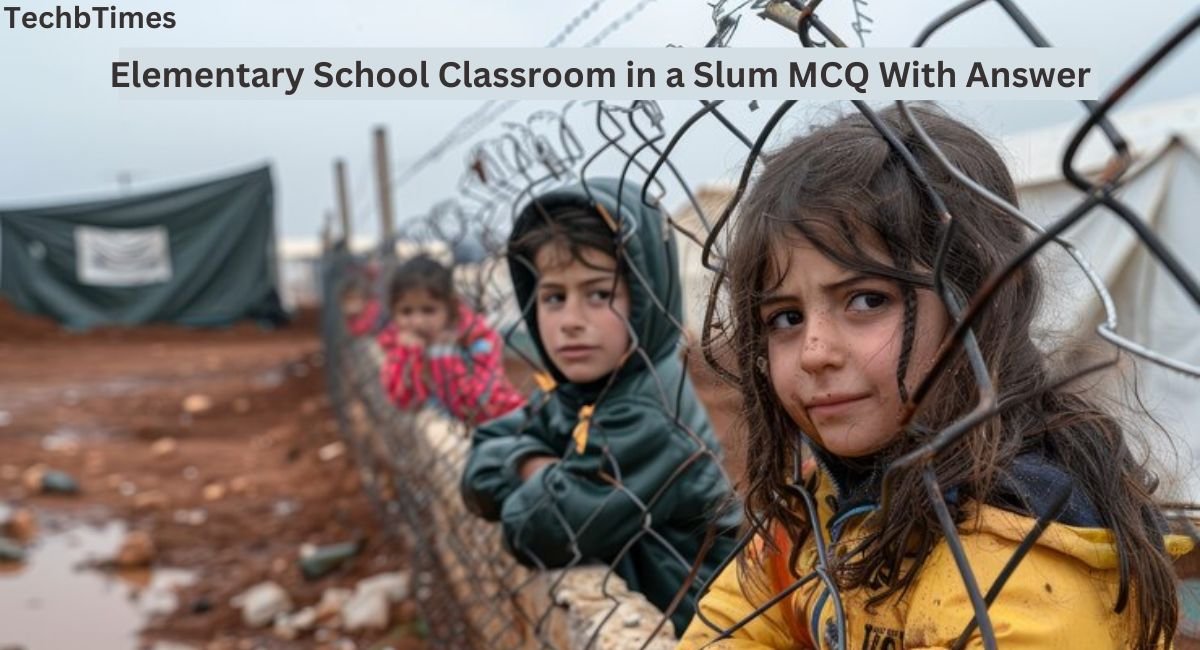Below are multiple-choice questions (MCQs) based on the theme of an Elementary School Classroom in a Slum MCQ, inspired by the poem by Stephen Spender or similar contexts. These questions test understanding of themes, imagery, and societal issues presented in such settings.
Table of Contents
Toggle1. What is the primary theme of an elementary school classroom in a slum?
a) The beauty of nature
b) The plight of underprivileged children
c) The importance of discipline in schools
d) The joy of childhood
Answer: b) The plight of underprivileged children
2. In the context of slum classrooms, the “foggy windows” often symbolize:
a) Clear vision of the future
b) Lack of resources and opportunities
c) The beauty of the slum
d) The cleanliness of the classroom
Answer: b) Lack of resources and opportunities
3. Which of the following best describes the children in slum classrooms as depicted in literature?
a) Bright and enthusiastic
b) Malnourished and weary
c) Wealthy and privileged
d) Carefree and happy
Answer: b) Malnourished and weary
4. What do the maps on the walls of the classroom represent?
a) The vast opportunities available to the children
b) The gap between their world and the larger world
c) The beauty of geography
d) The children’s knowledge of the world
Answer: b) The gap between their world and the larger world
5. How are the teachers in slum classrooms often portrayed?
a) As indifferent and powerless
b) As inspiring and motivating
c) As strict and disciplined
d) As wealthy and knowledgeable
Answer: a) As indifferent and powerless
6. The line “Their future is painted with a fog” implies:
a) The children have a bright future ahead
b) Their future is uncertain and bleak
c) Their future is full of adventure
d) Their future is already decided
Answer: b) Their future is uncertain and bleak
7. What does the “open-handed map” on the classroom wall fail to do?
a) Inspire the children
b) Show the boundaries of the world
c) Represent the harsh realities of their lives
d) Teach geography effectively
Answer: c) Represent the harsh realities of their lives
8. Why are the slum children described as “like rootless weeds”?
a) They are strong and thriving
b) They are neglected and lack stability
c) They are deeply rooted in their culture
d) They are rebellious and wild
Answer: b) They are neglected and lack stability
9. What is the poet’s appeal to the authorities regarding slum classrooms?
a) To build more schools
b) To bring real opportunities and hope to the children
c) To teach more subjects
d) To enforce strict discipline
Answer: b) To bring real opportunities and hope to the children
10. Which literary device is commonly used to describe the slum children’s condition?
a) Hyperbole
b) Simile and metaphor
c) Alliteration
d) Irony
Answer: b) Simile and metaphor
11. What do the “pallor faces” of the children signify?
a) Their excitement for learning
b) Their poor health and malnutrition
c) Their joy and happiness
d) Their rebellious nature
Answer: b) Their poor health and malnutrition
12. In the poem, the classroom walls are often described as:
a) Vibrant and colorful
b) Crumbling and neglected
c) Covered with motivational quotes
d) Clean and well-maintained
Answer: b) Crumbling and neglected
13. The slum children’s eyes are described as “like rats’ eyes.” What does this imagery suggest?
a) Their intelligence and curiosity
b) Their hunger and desperation
c) Their playful and mischievous nature
d) Their love for learning
Answer: b) Their hunger and desperation
14. What does the poet suggest as a solution to improve the lives of slum children?
a) Building more classrooms in slums
b) Breaking down barriers and providing equal opportunities
c) Encouraging the children to accept their fate
d) Offering them free meals
Answer: b) Breaking down barriers and providing equal opportunities
15. The “windows that shut upon their lives” symbolize:
a) The children’s connection to the outside world
b) The limitations and confinement of their lives
c) The beauty of the classroom
d) Their protection from external dangers
Answer: b) The limitations and confinement of their lives
16. What does the poet mean by “this map becomes their window”?
a) The map inspires them to explore the world
b) The map represents opportunities they cannot access
c) The map is the only source of knowledge for them
d) The map is a decoration in the classroom
Answer: b) The map represents opportunities they cannot access
17. Why are the children’s hair described as “torn around their pallor”?
a) To show their creativity
b) To highlight their untidy appearance due to neglect
c) To emphasize their happiness
d) To describe their playful nature
Answer: b) To highlight their untidy appearance due to neglect
18. What does the phrase “slag heap” refer to in the context of the slum classroom?
a) The children’s radiant future
b) The physical and emotional burden they carry
c) The wealth of the slum
d) The cleanliness of the classroom
Answer: b) The physical and emotional burden they carry
19. The poet describes the world outside the slum classroom as:
a) Full of opportunities and freedom
b) Similar to the slum
c) Restrictive and confining
d) Irrelevant to the children’s lives
Answer: a) Full of opportunities and freedom
20. What is the poet’s tone when describing the condition of the slum children?
a) Indifferent
b) Sarcastic
c) Sympathetic and critical
d) Joyful and optimistic
Answer: c) Sympathetic and critical
21. What do the “stars of words” symbolize in the poem?
a) The children’s potential and dreams
b) The wealth of the world
c) The brightness of the classroom
d) The children’s current reality
Answer: a) The children’s potential and dreams
22. How does the poet view education for slum children?
a) As a futile exercise
b) As a means to escape their harsh reality
c) As a burden they must bear
d) As unnecessary in their context
Answer: b) As a means to escape their harsh reality
23. The phrase “spectacles of steel” used for the children suggests:
a) Their strength and resilience
b) Their frailty and burdened existence
c) Their love for education
d) Their sharp vision
Answer: b) Their frailty and burdened existence
24. The poet uses imagery of nature, such as “green fields,” to symbolize:
a) The slum’s beauty
b) The opportunities that lie beyond their reach
c) The children’s imagination
d) The classroom’s surroundings
Answer: b) The opportunities that lie beyond their reach
25. What is the ultimate message of the poet regarding slum children?
a) They should accept their fate
b) They deserve access to a better life and education
c) Their condition cannot be changed
d) They are better off in the slums
Answer: b) They deserve access to a better life and education
Key Takeaways
These MCQs highlight the critical issues faced by children in slum classrooms, emphasizing themes of inequality, lack of opportunity, and the need for systemic change. Teachers and educators can use these questions to encourage discussions on social justice and education reforms.











